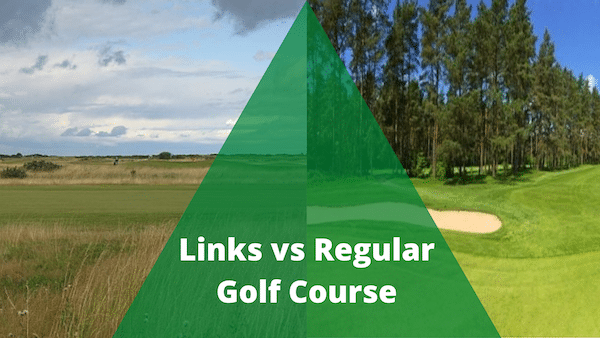Golfers often say, “Let’s hit the links,” when planning a round, but unless you’re playing next to the ocean, you’re technically using the term incorrectly. A links course isn’t just any golf course—it’s a specific style with unique characteristics, dating back to the very origins of the game.
So, what exactly is a links course? And how does it differ from other course styles like parkland, resort, or desert layouts? Let’s break it down.
A links golf course is named after the land it sits on (originally in Scotland). Links are a type of terrain, meaning coastal and often sandy dunes. So links courses have fewer trees and more wide open spaces.
But there’s more to learn about links-style golf courses (and how to act at private golf courses), which can help you find great courses to increase your enjoyment of golf.
What Is a Links Golf Course?
A links course is built on a narrow strip of land that connects the mainland to the sea. The key feature? The land itself. True links courses are constructed on sandy, coastal soil, which lacks the structural integrity to support buildings or roads.
Not all oceanside courses are links courses. Take Pebble Beach, for example—it sits on the Pacific Ocean but is not a links course because the land can support buildings and infrastructure. It’s the terrain, not just the location, that defines a links course.
Key Features of a True Links Course
- Sandy, saltwater-based soil
- Natural, wind-swept terrain with minimal human intervention
- Few or no trees (though some links courses may have a few)
- Fescue grass (but not all courses with fescue are links)
- Wider fairways with longer, wind-resistant grass
- Large greens to compensate for strong wind conditions
Where Are Links Courses Found?
The birthplace of links golf is the British Isles, particularly Scotland, England, and Ireland. Many of the world’s most famous courses—St. Andrews, Royal Troon, Carnoustie—fit this traditional mold.
In the U.S., links courses are rarer, but they do exist. Most are in the Pacific Northwest, where the sandy terrain resembles that of Western Europe. Bandon Dunes in Oregon is one of the best-known American links courses. On the East Coast, Fishers Island near Nantucket also fits the true links definition.
Links Golf Course vs Regular Golf Course

What is the difference between links golf and regular? A “regular” golf course, often referred to as a parkland course, is heavily designed and developed by an architect, whereas a links course retains a more natural, wind-swept terrain with minimal landscaping.
Parkland courses typically feature lush, tree-lined fairways and are built on fertile soil, making them softer and more forgiving. In contrast, links courses have firm, rolling fairways, sandy soil, and fewer trees, with wind playing a much greater role in shot strategy.
What does “links golf course” mean? A links course is a traditional style of golf course, typically found along coastal regions, featuring sandy soil, natural undulations, and minimal artificial design.
The best example of a links course is St. Andrews in Scotland, while Augusta National is a prime example of a parkland course.
Where Did Links Golf Courses Start?
The home of links golf is in Scotland, where playing links golf is common.
The links golf courses in Scotland are the earliest recollection of golf, and those courses were similar to links golf courses today. The Old Course at St. Andrew’s is where the modern game started in 1764.
Golf originated in Scotland and has a ton of history with the game of golf and traditions.
Flash forward to today, and there are links golf courses all over the United States and Europe. Most links golf courses are usually on the coastline of major bodies of water.
Why Are Links Golf Courses Popular?
There are several reasons why links golf courses are so popular, but the main reason is because of the challenge and uniqueness of the course. These courses are harder to play on.
The high winds and rolling fairways make the course play differently each time because you never know how the course will turn out on that particular day.
Sometimes the wind is such a factor that it can be a real problem for golfers and seriously inflate the scores in a golf tournament. Hopefully, this explains what a links course is, but there are other golf course styles besides the links-style golf course.
What Is the Most Popular Links Course?
St. Andrews is the most famous and most popular links course in the world. It is also the largest public golf complex in Europe. You have 10 different unique courses that you can play here.
Other Popular Links Golf Courses
Besides the infamous Old Course at St. Andrews, there are other incredible golf courses worldwide where you can swing for the golf holes.
- Whistling Straits is a popular links golf course in Wisconsin. The course has hosted the PGA Championship 3 times and a Ryder Cup.
- Another popular links golf course in the States is Pebble Beach Golf Links, which has hosted several major championships and major tournaments.
- In Europe, Ballybunion Golf Club Old Course and Turnberry Golf Club are some links golf courses that come to mind.
Links golf courses are an important part of golf’s history and are the best styles of golf courses to play, in my opinion. There are five main different types of golf courses, and you can see them played at PGA tour events sometimes.
What Is It Like To Play at a Golf Links Course?
True links courses typically have few or no trees, but some may feature sparse vegetation depending on the local landscape. They are characterized by sandy, saltwater-based soil and thick, wind-resistant grasses. Several deep pot bunkers are common, designed to prevent sand from being blown away by strong coastal winds.
Many golfers believe that a links course provides a greater challenge than a parkland course due to unpredictable wind conditions, firmer fairways, and larger greens that demand precise shot-making. However, the fairways and greens tend to be more spacious than those found on traditional courses, offering a different type of challenge rather than an outright easier layout.
What Are The Other Types of Golf Courses?
You have five main golf course types: parkland, desert, links, heathland, and sandbelt. Because we already mentioned links, we’ll leave that one out.
Parkland Golf Courses: The parkland golf course is your typical manicured golf course with trees and green grass. The fairway will usually look smooth, unlike the links course.
Desert Golf Courses: Desert golf courses were built into areas where natural desert occurs. They constructed them among natural sand dunes. You only find grass on the putting greens, the fairways, and the tee box.
Heathland Golf Courses: This golf course is inland and less manicured than the other choices. Usually, it’s less wooded than a parkland golf course, but you still see plenty of trees.
Sandbelt Golf Courses: These golf courses were built in regions with sandy soil, and you often find bunkers on them because of the ease of placing them. You can carry sand from one place to the next easily.
Common Misconceptions About Links Courses
Clint McCormick shared some common misconceptions about links golf courses. Here are a few that everybody seems to get wrong.
“Links courses have no trees.”
Not always. While most links courses lack trees due to coastal conditions, some may have a few scattered throughout the landscape. The defining factor is still the terrain and soil composition, not just the absence of trees.
“If a course has fescue grass, it must be a links course.”
Many European courses feature fescue, but that alone doesn’t make them links courses. If a course has fescue but isn’t near the ocean, it’s likely a heathland course—similar in design but without the coastal influence.
“Links fairways are always firm and fast.”
While firm, links fairways are not cut as tightly as other course styles. The longer grass helps prevent excessive roll in high-wind conditions, which could make the course nearly unplayable.
“Links greens are small and difficult.”
Quite the opposite. Links courses generally feature larger greens to accommodate the unpredictable wind, making it easier to land approach shots. Even the best players struggle to hold greens when conditions get tough—just watch the Open Championship for proof.
The True Links Experience
- If you ever find yourself on a course where:
- The wind is howling
- The fairways are rolling and rugged
- The greens are large and undulating
- And a bagpiper is playing in the clubhouse…
Chances are, you’re on a true links course—especially if the bagpiper is wearing a kilt.
FAQs
Why Are Links Golf Courses Called Links?
The word “Links” originates in the Scots language and refers to the coastal sand dunes. This may explain why most of the links golf courses that you will encounter are situated near coastal regions.
Is Augusta a Links Course?
Augusta National is a links course, and it was inspired by the Old Course, which is a famous links course. Mackenzie and Bobby Jones, in fact, studied the Old Course to take their inspiration for Augusta.
Who Plays the Best on Links Golf Courses?
Jordan Spieth is considered the best links golf player and holds a record that sets him quite ahead of the other golf players. He has the best rate out of any player when counting over 300 players.
What’s the difference between a golf course and a links course?
All links courses are golf courses, but not all golf courses are links courses. Links style golf courses differ from others because a general golf course can have various designs (parkland, desert, resort, etc.), while a links course is a specific type built on coastal, sandy terrain with natural, wind-swept conditions, minimal trees, and firm, rolling fairways.
What Is the Most Successful Pro Player on the Golf Links Course?
Jordan Spieth holds the record on the golf links course as the best among more than 300 players. Starting in 2015, he had an average of 2-and-a-half strokes gained. That gives him the best rate out of all the other players. Among the 300, only nine other golf players averaged 1-and-half strokes, which explains why Spieth holds the title.
Related Articles
- What is an Executive Golf Course? And Who Can Play One?
- How Many Acres is a Golf Course?
- How Much Does It Cost To Build A Golf Course?







